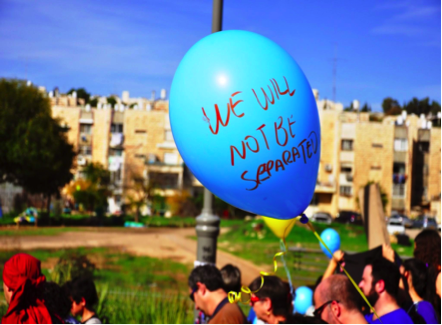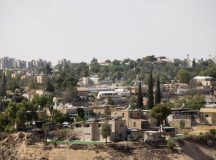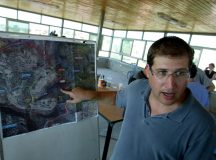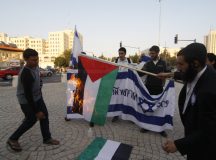‘Second Israel’ is the key to modern Israeli politics not just to Netanyahu’s victory in 2022. These Israelis, largely made up of the country’s Mizrachi Jews, suffered discrimination historically, are religiously more traditional, earn less, enjoy inferior education compared with the establishment and reside in second-tier Israeli cities, underprivileged neighborhoods, and the under-served communities of Israel’s geographic periphery. Second Israel tends to be more nationalistic and suspicious of peace and reconciliation efforts. The left’s growing failure to attract ‘Second Israel’ has been the alpha and omega of Israeli politics since the late 1970s. Sam Shube, Executive Director of the Hagar Association, argues that one response to this ideological and cultural polarisation is to celebrate the cultural roots that Jews and Arabs share as one foundation of a truly democratic and pluralistic society.
It was March, 2022. With Israel’s razor thin, centrist coalition reeling under incessant pressure from Netanyahu and his allies, Meretz health minister Nitzan Horowitz found it expedient to champion a burning civil rights issue – freedom to bring leavened bread into hospitals on Passover, in violation of Jewish religious strictures – thereby helping to trigger the government’s terminal death spiral. By the fall, Israel was in the throes of a new election. With a disciplined right-wing juggernaut threatening the very institutions of democratic life, Labor Party billboards proclaimed a new and ingenious slogan: public transportation on the Sabbath. Yes, it is sad, but true. You cannot get a bus in Tel Aviv on a Saturday. Nor can you get a decent slice of pizza. Predictably, Israeli socialism suffered an historic rebuff, with Meretz disappearing altogether and Labor – still claiming the mantle of Yitzhak Rabin – garnering just four out of 120 seats in parliament, compared with the latter’s 44 back in 1992.
Benjamin Netanyahu, meanwhile, rode a wave of a clerico-nationalism back to power. His cynical alliance with racist ideologues – who are supported by no more than 11 per cent of the electorate – was fundamentally utilitarian in nature.
‘Second Israel’ and Modern Israeli Politics
The Likud itself, Bibi’s own party, represents something entirely different: a solid and enduring class-based segment of Israel’s Jewish majority known, in contemporary parlance, as ‘Second Israel’. Netanyahu’s ability to harness this constituency to a tripartite alliance including fascists on the one hand and an emboldened ultra-orthodoxy on the other is an Israeli tragedy, and an indictment of the country’s democratic left. Its results, however, are unmistakable. The Netanyahu coalition dominated November’s voting in towns where Second Israel predominates (Kiryat Shemona – 75 per cent, Dimona – 81 per cent, Netivot – 92 per cent); losing decisively in the heartland of Israel’s socio-economic elite (Tel Aviv – 26per cent, Ramat Hasharon – 24 per cent, Ramat Gan – 34 per cent).
Second Israel is religiously more traditional, earns less and enjoys inferior education compared with the establishment. It is largely coterminous, though not synonymous, with the country’s Mizrachi Jews (the term is an ethnic counterpart for the religious-liturgical name ‘Sephardic’) – those of North African and Middle Eastern provenance. Its members reside in second-tier Israeli cities, underprivileged neighborhoods, and the under-served communities of Israel’s geographic periphery. Immigrating en masse during the country’s formative decades, they were met by an entrenched socialist elite of largely Ashkenazi (European) origin. The latter controlled all of Israel’s main power levers, including the Histadrut Trade Union Federation, the Jewish Agency and government ministries, giving them full control over housing, education and employment in the country’s fledgling, proto-capitalist economy. Mizrachi immigrants were sent to build farms in the periphery, while the elite settled on prime real estate in Israel’s nascent cities. The children of Second Israel, judged incapable of academic achievement, were taught metalwork at trade schools. The establishment, meanwhile, sent its own kids to universities, where they proceeded to build careers in academia, the court system and the media, the very institutions now under merciless attack by Netanyahu and his populist spin-doctors. To be sure, the ensuing years have witnessed the rise of a new, Mizrachi middle class, but Ashkenazim always seem to have a leg up. Many Mizrachi youth fulfill their mandatory army service in border police or infantry units performing occupation duty on the West Bank, their formative adult experiences spent policing disenfranchised Palestinians. Children of Ashkenazim, for their part, aspire to serve in the army’s elite cyber units, positioning themselves for rewarding careers in hi-tech upon discharge.
Israel’s Mizrachim came of age politically in 1971, launching a textbook, class based, inner-city resistance movement, consciously modeled on African American protests and provocatively named the Black Panthers in an effort to rattle the establishment’s emotional cage. But this social democratic moment was not to last. Menachem Begin’s right wing Herut party, subsequently the Likud, was the big winner. Begin had consistently sided with Mizrachim against the euro-socialist power elite. His visage and Hebrew syntax were thoroughly Ashkenazi, but his respect for religious tradition mirrored Mizrachi immigrant values. Above all he was – like them – a perennial underdog. In 1977, Begin put an end to 50 years of socialist hegemony in Israeli politics. Mizrachi identification with the right has only solidified over the years.
Once in opposition, the Israeli left took to civic action, establishing Peace Now in 1978 to oppose Israel’s occupation of the West Bank and Gaza. For right wing ideologues, the left’s ‘sudden’ discovery of Arab oppression was a transparent attempt by the elite to reclaim the power it had lost at the ballot box. So, too, is its current effort to prosecute Netanyahu for corruption. This argument, to be sure, is sheer demagogy, but it does tap into a deeply held public sentiment, one that now charges a toxic and unstable political atmosphere. Bibi’s new government, for instance, has given top priority to neutralising the judicial system, wielding an ethnic truncheon to mobilise its own base. Only one out of ten Supreme Court justices is Mizrachi, they sneer. It hardly matters that Bibi himself, the target of three major indictments, is himself an Ashkenazi millionaire.
One tragedy of the rightward march of Mizrachi voters is the growing tolerance of anti-Arab racism; this despite a political undercurrent that has always highlighted the common cultural roots Mizrachim share with the Arab societies from which they came. Shas, for instance, the Sephardic ultra-orthodox party, once held the most moderate views on peace in the orthodox camp, though it is by now a loyal Netanyahu ally. Bibi, for his part, has deliberately fomented the rise of extreme nationalism in Second Israel. He engineered, for instance, the rehabilitation of a formerly banned racist political movement founded by American immigrant Meir Kahana, now under the leadership of the Mizrachi Itamar Ben Gvir. The latter’s party scored third in the November elections, earning him a cabinet portfolio in charge of the police, where he now relishes photo ops at the scene of terrorist attacks, egged on by angry crowds. It is a painful irony. In 1971, Israel’s Black Panthers attacked the offices of Meir Kahana’s Jewish Defense League in Jerusalem, trashing the place and beating his Brooklyn accented goons to a pulp.
At the end of a close election campaign in 2015, Netanyahu energised his political base with a hysterical get-out-the-vote appeal: ‘Arab voters are coming to the polls in droves on busses funded by left wing organisations.’ It worked. What is it about this country’s public discourse that makes Second Israel so vulnerable to racist political rhetoric? The truth is we have no real public discourse, only a pervasive set of cultural dog whistles that drive political behavior. Hostility towards Arabs seems to be hard-wired into the system; a system built by the Zionist left itself. From Israel’s inception, its Eurocentric, socialist elite viewed the Middle Eastern culture Mizrachi immigrants brought with them as inherently primitive – their music, their religious traditionalism, their large families, their guttural Hebrew pronunciation. Schools socialised Mizrachi children to feel ashamed of their parents’ Arabic speech, forcibly Hebraising the French or Arabic names they were given in North Africa. Public radio and television feted the ‘Israeli’ songs of Ashkenazi artists. The syncopated rhythms favored by North African Jews were termed ‘ethnic’ music, if they received any airtime at all, at best a soundtrack for images of retreating Arab armies, crushed on the sands of the Sinai desert by the superior arms of Labor Party generals like Moshe Dayan. Generations of Mizrachim internalised a hostility towards anything Arab – in others or in themselves. The cultural chickens, so to speak, have come home to roost.
Back to the present. The city of Beer Sheva, metropolitan center of the Negev desert, helped put Netanyahu back in power with a 66 per cent vote for his coalition in November. This town’s right leaning, heavily Mizrachi Jewish electorate mirrors southern Israel as a whole. But some ten per cent of the Beer Sheva’s residents are Arabs, and a much bigger share of its business community, reflecting the large Bedouin population of surrounding villages. 33 per cent of Negev residents are Bedouins who live in the poorest, most under served and most crime-ridden communities in Israel. 80,000 of them make their homes in unrecognised villages, off the electric grid, with no running water. The encounter between Jews and Bedouins in Beer Sheva’s hospital, university, courts, government offices and shopping centers is part of the daily rhythm of life – colorful, diverse, and increasingly tense. The Negev witnessed three rounds of Arab Jewish confrontation in 2021. Conflict with Gaza, government appropriation of Bedouin claimed land, terrorist events – all are easy triggers for ethnic violence. And when that happens, Bedouin students fear to attend classes on campus, and Jews fear to drive past Bedouin towns on the open road.
The Hagar Association: Visions of an Alternative
It was, therefore, no small matter that in January 2023, with Israel’s extreme nationalist government consolidating power in Jerusalem, Beer Sheva’s performing arts center hosted its first ever Arab-Jewish concert. Conceived by the Hagar Association – the modest, educational nonprofit which I manage – the event featured prominent Jewish and Arab artists singing Middle Eastern music in both Hebrew and Arabic. It was sold-out weeks in advance. The audience – a mix of Mizrachim and Arabs, sang along heartily with the familiar tunes. Yossi Revach, a performer of traditional Sephardic, High Holiday music, fondly recalled the history of Arab-Jewish cultural cooperation to enthusiastic applause.
People danced in the aisles. At least one of them, I am told, had published a vitriolic Facebook attack on ‘leftists’ just days earlier. It was the kind of magic that culture can engender when you leave politics behind.
In 2007 the Hagar Association launched a bilingual, Arab Jewish kindergarten in Beer Sheva. It has since grown to become a full-fledged elementary school program – the only one of its kind in southern Israel – with 380 children who study both Arabic and Hebrew, and learn together about the religious traditions of the three monotheistic faiths. The region’s largest, Arab Jewish community has grown up around the school, with parents and siblings coming together for regular weekend family outings, celebrating each other’s holidays and building life-long friendships.
Eventually, however, we realised that to touch the lives of a million people in Negev, we had to reach way out beyond the school community itself. Our first target was informal education. In 2019, we set up Scout Troop Adam, Israel’s only, integrated Arab Jewish scout troop, open to all children throughout the city. The program has grown rapidly from a dozen kids to over a hundred in just three years. In 2021, we took a quantum leap forward, establishing the Center for Shared Culture in the Negev, also known as the Thaqafat initiative (‘cultures’, in Arabic). Filling what we saw as a gaping social vacuum, we launched a series of shared cultural events that shook up the region’s often sleepy, social routine. In March 2022, we organised the first ever concert in the new performing arts center in the Bedouin city of Rahat. Hundreds of Arabs and Jews filled the hall to hear a thirty-piece ensemble play the music of the late Egyptian diva Um Kulthum, defying expectations that traditional Bedouin audiences would never countenance the appearance of female vocalists. In April, we organised the first joint celebration of Passover and Ramadan at a public venue in Beer Sheva, combining Ifthar (the Ramadan break-fast meal) and Mimouna (the end of Passover celebration). We have since organised two Arabic-Hebrew poetry readings, and an alliance of Bedouin and Jewish artists from communities across the Negev. At the heart of it all is an understanding that the cultural roots Jews and Arabs share predate Israel’s ubiquitous ideological polarisation, and must once again come to the fore if we hope to build a truly democratic and pluralistic society in this country.
Shared culture, to be sure, is no solution to political deadlock. As we write these words, the Israeli right is pursuing a seemingly inexorable campaign to dismantle the institutions of Israeli democracy. But somehow I have the feeling they’ve reached their high water mark. Even the most toxic rhetoric has its limits. Deep below the surface, the tectonic plates of Israel’s reified group identities – Jewish, Arab, Mizrachi, Ashkenazi, Bedouin – are all beginning to shift. Shared society may be the soundtrack of a new and inclusive cultural paradigm.
Lyn Julius’ reply to this article can be read here.






































You begin with an analysis of why the “Mizrahi” Jews vote on the right, i.e., due to the left establishment’s mistakes of the past and its attempt at erasing, manipulating and molding a culturally “inferior” population. The so -called superiority complex of the leftist ashkenazi elite. Then you proceed at finding ways to encourage arab-jewish dialogue, reviving arab identity pride, but OBVIOUSLY ONLY AS A MEANS OF LURING BACK THE MIZARAHI JEWS INTO THE ARMS OF THE ISRAELI LEFT WHO HAS CHOSEN TO EMBRACE THE ARAB MINORITY, which smacks no less of manipulation and superiority sentiment.
Get it straight: Mizrahi jews are a pragmatic bunch and are more religiously oriented and proud to be Jewish. The left establishment is dogmatic to a nervewracking point, “peace and love” made in Oslo, it is secular and prefers to look democratic in the “eyes” of the West rather than walk humbly and simply as a normal Jew should in its God-given land.
Good luck with your hagar initiative
Thank you for an excellent article, and the response by LYN JULIUS, both informative, and both explaining in different ways why Mizrachi Jews are more inclined to vote in favour of right leaning parties.
I’ve read a lot over the last couple of years to try to understand the issues facing Israel, and though there’s been hints of differing voting patterns for Mizrachi and Ashkenazi communities, it’s refreshing to read articles detailing the reasons why, and it’s also SOOOOO refreshing to see 2 people having a respectful and polite difference of opinion.
I’d been searching for these types of articles since hearing a thought provoking
opinion a while ago, I heard that some Mizrachi Jews can’t forgive the Ashkenazi ‘elite’ for their treatment over generations, and because of this, they feel the Palestinians won’t be able to forgive, and as a result, many Mizrachi Jews are less likely to vote in favour of any potential peace deal in the near future, is this a widespread feeling in the Mizrachi community?
Off topic – I’d love to read an article on why pre-48 Russian/East European immigrant Jews were predominantly left leaning (and went on to dominate Israeli politics until Begin), and post 80’s Russian immigrant Jews were predominantly right leaning, I just can’t find any explanation.
“Occupation duty”, eh?
Ever heard of The League of Nations Mandate that endorsed the valid , legitimate claim of the Jewish People to all of Israel west of the Jordan River?
Besides, the consensus view in Arab societies, as well as in large sections of the Western left, is that all of Israel is occupied.
One can argue the merits or otherwise of retaining control over this or that piece of land, but to claim illegality and occupation offends truth and is a slander that is echoed by antisemites all over the globe.